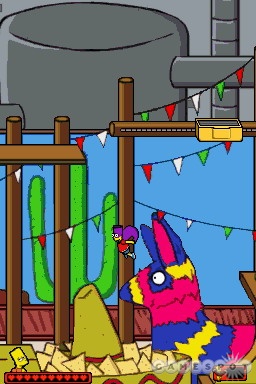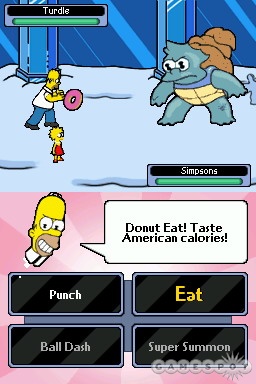As you play through The Simpsons Game on your Nintendo DS, you'll find yourself cracking one smile after another in response to all of the irreverent references the game makes concerning the TV show, pop culture in general, and the video game industry. The game itself is a varied 2D platformer that shamelessly borrows concepts from dozens of popular video games, which are constantly lampooned by the characters, both during the levels and in the lengthy animated scenes that play out after each mission. It won't take you long to work through the game (five hours, at most), but you'll be satisfied from start to finish thanks to the inventive gameplay situations, the video-heavy presentation, and the satirical sense of humor that pervades everything that's displayed onscreen or piped through the speakers.
The plot of the game revolves around Bart's discovery of a magical instruction manual that gives each member of the Simpsons family unique video game powers. At first, Bart, Homer, Marge, and Lisa use their newfound abilities to defuse everyday situations. Bart and Homer stop a robbery at the museum. Marge and Lisa lead a mob to get Grand Theft Scratchy banned. Soon, they come to realize that the city of Springfield has been transformed into dozens of side-scrolling, isometric, and minigame levels, and that its residents have been corrupted into the bad guys and bosses populating those levels.

There's nothing especially noteworthy about how the levels are set up. For most of them, you alternate control between two of the Simpsons characters and use their abilities in conjunction with the usual sort of running, jumping, and lever pulling you'd normally find in any platform-style game. You'll also find yourself frequently pressing the attack button to unload punches and kicks on the ill-intentioned denizens of Springfield who liberally populate each level. What makes the levels fun is, first, how bizarre they are. Beating up chocolate bunnies and riding marshmallows in rivers of chocolate in Homer's dream world is ridiculous. So is shuffling blocks and ascending the clouds on a giant stack of Tetris bricks in one of Lisa's levels.
Secondly, the characters' abilities are downright awesome. Homer can eat food and transform into a giant ball-shaped "fatso" that can squish enemies and shatter walls. Bart has a slingshot that comes in handy against distant enemies and switches, but his true usefulness stems from his ability to transform into his alter ego, Bartman, who can float through the air and swing across hooks using his utility rope. Throughout the game, Lisa gradually develops telekinetic abilities that let you rearrange objects in the environment and electrocute enemies simply by dragging and tapping things with the stylus. Marge, the mother of the clan, has only one real ability, but it's a doozy: She can convince people to form a mob. Using the stylus, you can tap spots on the touch screen to make the mob attack enemies or destroy obstacles that are in your way. The majority of levels borrow a page from the Lost Vikings playbook and pair up two of the characters. For example, you'll swing across hooks and pull a lever as Bart, which will cause a ramp to fall from the sky--which you'll then use to launch Homer's fatso form onto an upper floor.
Visual and spoken references to The Simpsons TV show, as well as to popular movies and fads, are frequent. By and large, however, the whole game is a delicious send-up of the video game industry. When you fall into a pit, bounce off a trampoline, or act out some other video game cliché, Comic Book Guy will appear on the upper screen and say a few words about it. One level is a sweatshop, in which dwarves that look suspiciously similar to Mario, Luigi, and Sonic toil while you constantly battle fireball-throwing people who are dressed up just like Ryu from Street Fighter 2. In another level, you have to stop Will Wright, creator of The Sims, from destroying an 8-bit game cartridge. As you jump across falling platforms and pull levers to break the factory, he'll fly around on his Sim crystal chariot and utter comments like "It's OK, Will, just think about your money." Some levels are specifically patterned after classic games. You'll hop across floating logs to reach the other side of a pond, you'll climb a multilevel factory to reach an ape that's tossing barrels at you, you'll traverse a top-view dungeon beating up enemies and the huts they spawn out of in search of keys that'll unlock the exit, and so on. There's even a Homer virtual pet you can feed and play with whenever you're not tackling a mission.
Within the missions, the hand-drawn backdrops and characters bear a striking resemblance to their TV counterparts. The style is crude but detailed--just like the Simpsons cartoon show. Loads of familiar characters appear as enemies, bosses, or in whimsical cameos, and you'll be treated to a good variety of vocal comments as you interact with those characters and the environment. Before and after each mission, animated clips featuring the actual voice actors from the cartoon play out to move the story along. These clips are lengthy, and the overall quality of the video and audio is top-notch. More importantly, the quality of dialogue, the sense of humor in the delivery, and the artistic quality of the animation are all just as good as what you see in the episodes you watch on TV.

One nugget of information that may or may not be important to you is the game's T rating, which wasn't assigned just because every level involves beating the stuffing out of the transformed people of Springfield. Some characters actually speak off-color dialogue. At one point, Will Wright ends a sentence, no doubt inspired by Chappelle's Show, with the word that means female dog or cranky woman. In an animated scene, Bart and Homer stop to relieve themselves on someone's lawn. These naughty words and happenings fit the context of the situations they're presented in, so they don't seem out of place. However, this is definitely one of those instances where the rating is a strong suggestion not to put the game into the hands of young children, unless you want to risk them learning a few colorful words and perhaps doing something disgusting on your plants.
The most disappointing thing about the game is that it takes only about four hours to get through all 20 or so missions. You can tack another hour onto that tally if you intend to go back and replay missions to collect any bottle caps, Malibu Stacy tickets, or other collectible items you may have missed. On the upside, the touch-sensitive map of Springfield makes it easy to replay individual missions and minigames, and to rewatch animated clips. You can also kill time by taking advantage of the multiplayer mode, which lets you compete in combat and keep-away games with as many as three other people using multiple DS systems and a single game cartridge. Whether five-plus hours is too short or just right is up to you. Either way, The Simpsons Game for the Nintendo DS is one heck of a ride while it lasts.